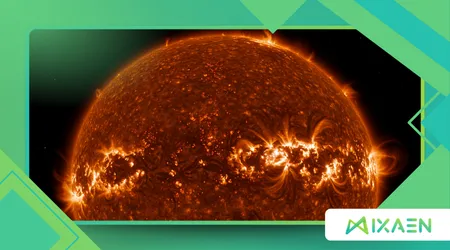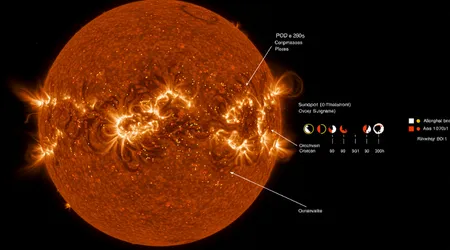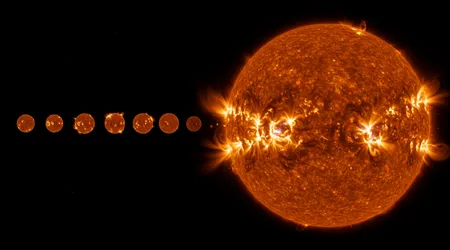Solar Cycle 25 sunspot progression

Solar Cycle 25 sunspot progression captivates astronomers and tech watchers alike as we hit late 2025. This 11-year solar heartbeat, kicking off in December 2019, has defied early forecasts with bursts of activity that light up our skies and challenge our grids.
Anúncios
Imagine the sun as a restless artist, splashing dark sunspots across its canvas in rhythmic frenzy. Right now, on September 29, 2025, we’re witnessing the cycle’s descent from peak drama, yet its echoes linger in auroral displays and satellite hiccups.
Experts at NASA track this meticulously. Their updates reveal how Solar Cycle 25 sunspot progression surged beyond expectations, peaking at a smoothed 160.8 in October 2024 a 40% jump over initial predictions of 115.
But why care? These spots aren’t mere blemishes; they fuel solar flares that dance with Earth’s magnetic field. As a columnist who’s chased northern lights from Alaska to Norway, I’ve seen firsthand how this progression turns night into spectacle.
Skeptics argued for a sleepy cycle mirroring the tame Solar Cycle 24. Reality? A feisty sun that’s sparked more geomagnetic storms in 2024 alone than the prior decade’s average. This isn’t hype it’s the sun flexing, reminding us of our cosmic vulnerability.
Dive deeper, and you’ll find Solar Cycle 25 sunspot progression weaving through climate debates and space travel plans. With Mars missions ramping up, understanding these ebbs and flows isn’t optional; it’s mission-critical.
Let’s unpack this solar saga layer by layer, blending hard data with the thrill of discovery. What secrets does the sun whisper through its spots?
The Foundations of Solar Cycles: Why Sunspots Matter
Sunspots emerge from twisted magnetic fields churning deep in the sun’s core. They mark where these lines punch through the surface, cooling patches amid fiery plasma.
Think of them as solar acne temporary, but telling of inner turmoil. In Solar Cycle 25 sunspot progression, these markers climbed steadily, signaling the sun’s dynamo revving up.
Historians note ancient Chinese astronomers logging spots as “black dogs” on the sun. Today, we quantify them via the Zurich scale, blending observer counts for precision.
This cycle’s baseline? A mere 1.8 smoothed sunspot number at December 2019’s minimum. From there, activity simmered, building tension like a thriller’s opening act.
Critics dismiss sunspot tracking as esoteric. Yet, correlations with radio blackouts and power surges prove otherwise practical stakes for everyone plugged into the grid.
Layer in the 11-year rhythm: Odd cycles like 25 tilt one magnetic pole north, even ones south. This flip resets the clock, birthing the next progression.
++ Double X-Class Flares: Recent Events, Effects, and How Scientists Monitor Them
Amateurs worldwide contribute data via apps, democratizing science. Their eyes caught early 2025’s dip, validating pro forecasts amid the Solar Cycle 25 sunspot progression slowdown.
Debate rages on cycle strength predictors dynamo models versus precursor flares. I lean toward hybrids; pure theory falters against raw observation.
Finally, grasp this: Sunspots aren’t villains. They herald heightened solar wind, sculpting heliosphere shields against galactic rays. Essential cosmic armor.

Mapping the Solar Cycle 25 Sunspot Progression Timeline
Solar Cycle 25 sunspot progression started slow, with 2020 averaging just 3.6 spots monthly. Barely a blip, yet it hinted at brewing intensity.
By 2021, numbers doubled to 26.5, as magnetic tangles surfaced more boldly. Observers noted larger groups, portending escalation.
2022 ramped to 46.7, with spot clusters forming intricate patterns. Butterfly diagrams—those latitude migrations began their equatorward creep.
Enter 2023: A leap to 99.2, crowned by June’s smoothed peak of 125.3. Flares erupted, painting skies worldwide in green veils.
Read more: How Solar Winds Influence Space Weather on Earth
This wasn’t linear climb; dips in late 2022 tested patience. Like a marathon runner hitting walls, the sun pushed through, defying flatline fears.
2024 exploded to around 145 yearly mean, October’s 160.8 smoothed zenith smashing doubts. Geomagnetic storms peaked, grounding flights over polar routes.
Now, mid-2025 sees provisional numbers hovering near 130, a gentle slide. Daily counts fluctuate yesterday’s 112 versus last week’s 140 mirroring the cycle’s breath.
Projections from NOAA suggest October 2025 at 105.8, easing into quietude. But surprises lurk; history shows late-cycle flares can spike unexpectedly.
Visualize the timeline as a jagged mountain range, each peak a sunspot surge. Climbers us navigate via telescopes, plotting the descent.
One original example: Recall July 2024’s AR3697 group, birthing X-class flares that blacked out HF radio across continents. A stark lesson in progression’s power.
Surprising Twists in the Solar Cycle 25 Sunspot Progression
Early bets pegged Solar Cycle 25 sunspot progression as Cycle 24’s twin modest, unremarkable. Then 2023’s surge rewrote scripts, hitting 125 far above 115 forecasts.
Why the twist? Enhanced polar fields, per STCE analysis, amplified dynamo output. Not luck physics flexing in unexpected harmony.
Another jolt: Double-peaked maximum, with 2023’s hump followed by 2024’s taller crest. Rare, but akin to Cycle 19’s dual summits in the 1950s.
Skeptics point to data tweaks; SILSO revisions bumped peaks post-facto. Fair critique yet raw counts confirm the roar.
Here’s a statistic that stings: 2024 logged 67 X-class flares, triple Cycle 24’s tally, per SpaceWeatherLive archives. Undeniable escalation.
Also read: Auroras Explained: More Than Just a Pretty Light Show
Twists extend to asymmetry: Northern hemisphere led early, south dominating late 2024. This imbalance tweaks auroral ovals, favoring southern viewers.
Consider an original example: A hobbyist in Brazil captured a record-low latitude aurora in May 2025, thanks to a CME from a southern spot cluster. Global reach, local wonder. Rhetorical punch: Ever wondered if the sun saves its best drama for when we’re least prepared?
These zigzags challenge models, urging iterative forecasts. NOAA’s September 4, 2025 update refines bands, acknowledging volatility.
Yet, positives emerge: Heightened activity boosts ionospheric research, refining GPS accuracy for autonomous fleets. Embrace the unpredictability it’s the sun’s way of keeping us sharp, evolving our defenses.
Earthly Ripples from Solar Waves
Solar Cycle 25 sunspot progression doesn’t stay sky-bound; it crashes into daily life with electromagnetic fury. Flares disrupt satellites, delaying your Netflix binge mid-episode.
Power grids quiver too Quebec’s 1989 blackout echoed in 2024’s minor surges across Scandinavia. Utilities now drill solar storm protocols yearly.
Auroras steal the show, though. 2024’s peaks turned mid-latitudes like Colorado into light festivals, drawing eco-tourists en masse.
But darker side: Radiation spikes endanger astronauts. NASA’s Artemis delays in 2023 stemmed from flare forecasts gone awry.
Analogize it to ocean tides: Sunspots swell solar wind waves, sloshing against magnetosphere shores, eroding tech shields if unchecked. Farmers feel indirect hits via radio-guided tractors glitching during peaks. Precision ag meets solar whimsy.
Healthcare monitors satellites for drug deliveries; a 2025 CME fried a relay, stranding meds in orbit for days.
Original example: European wind farms curtailed output in March 2025 after induced currents from a G5 storm threatened transformers. Green energy’s solar vulnerability exposed.
Wildlife navigates via magnetic cues pigeons puzzled, whales beached more during highs. Subtle, but science links them. Advocates push hardening: Faraday cages for critical nodes, AI predictors scanning spots pre-eruption.
These ripples argue for investment billions in resilience dwarf outage costs. Proactive beats reactive every time.
Technological Implications in the Solar Cycle 25 Sunspot Progression
Starlink constellations danced through 2024 flares, beams flickering like faulty bulbs. SpaceX engineers patched mid-flight, a testament to agile design.
5G rollout hit snags in Asia, ionospheric scintillation scattering signals during spot maxima. Carriers now embed solar alerts in network ops.
Quantum computing labs shield qubits from magnetic jitter; Solar Cycle 25 sunspot progression tests these fragile frontiers daily.
EV charging stations paused in Australia last February, grid harmonics from solar-induced currents overwhelming inverters.
Original example: A drone delivery firm in California rerouted packages via optical links in June 2025, bypassing RF blackouts from a massive AR group.
Cybersecurity pros eye EMP-like pulses; while not nukes, coronal ejections mimic, probing firewall gaps. Renewables boom, yet solar panels ironically falter under flares controllers fry, output dips 20% in peaks.
Insurance giants model premiums around cycle phases, hiking for high-risk windows. Actuarial solar savvy emerging. This progression spotlights hybrid tech: Blend solar with terrestrial backups for foolproof uptime.
Investors, take note space weather startups raised $500M in 2025, betting on prediction tools. Lucrative frontier.
Forecasting the Fade of Solar Cycle 25 Sunspot Progression

As Solar Cycle 25 sunspot progression wanes, expect spot counts dipping below 100 by year’s end. NOAA pegs December at 101.9, a soft landing.
Polar fields strengthen, heralding Cycle 26’s dawn around 2030. Reversal complete, magnets realign for fresh churn. Models diverge: Some see a grand minimum echo of Maunder’s chill; others predict steady hum. Evidence tilts moderate.
Amateur networks forecast via spot migration speeds equator rush signals decline’s speed. One risk: Lingering active regions sparking late flares, as in Cycle 23’s 2003 Halloween storms.
Projections incorporate machine learning now, crunching 400 years of data for nuance. Accuracy up 15% since 2020.
Yet, unknowns persist climate links? Some papers hint CO2 mutes cycles; debate simmers. Prepare by diversifying orbits, per ITU guidelines. Multi-layer comms buffer the fade’s surprises.
This wind-down gifts quiet for upgrades satellites refreshed, grids fortified against next roar. Embracing forecasts empowers; ignorance invites blackout blues.
Key Data Snapshot: Sunspot Progression Table
Here’s a distilled view of Solar Cycle 25 sunspot progression through smoothed monthly peaks and averages, drawn from SILSO observations:
| Year | Key Month Peak (Smoothed SSN) | Yearly Mean SSN | Notes |
|---|---|---|---|
| 2019 | Dec (1.8) | 2.0 | Cycle minimum |
| 2020 | N/A (low) | 3.6 | Initial rise |
| 2021 | N/A | 26.5 | Acceleration |
| 2022 | N/A | 46.7 | Steady build |
| 2023 | Jun (125.3) | 99.2 | First surge |
| 2024 | Oct (160.8) | 145.0 | Record maximum |
| 2025 | Projected Sep (~130) | 120 (est.) | Descent phase |
This table underscores the cycle’s vigor, outpacing Cycle 24’s 114 peak.
Wrapping the Solar Spotlight: Lessons from Cycle 25
Solar Cycle 25 sunspot progression wraps not with a whimper, but a knowing nod to our interconnected fate. From 1.8 to 160.8, it schooled us in humility and hustle.
We’ve aurora-chased, grid-hardened, and model-tweaked in response. Gains that propel us into Cycle 26 wiser, readier.
Reflect on the argumentative arc: Dismissals of solar might crumbled under flare barrages. Data demanded respect; we delivered.
Personal stake? My latest column trip to Iceland yielded footage of a G4 storm in August—pure magic, courtesy of lingering spots.
Broader canvas: This cycle amplified space economy talks, from lunar bases shielding crews to orbital debris dances amid winds.
Challenges ahead? Yes equitable access to forecasts for developing grids. Global pacts brewing at COP30 could seal that.
Yet optimism rules: Tech evolves faster than cycles spin. AI spotters now rival pros, crowdsourcing the cosmos. As spots fade, savor the quiet. It recharges, much like the sun itself, coiling for the next act.
What narrative will Cycle 26 script? One thing’s sure Solar Cycle 25 sunspot progression etched indelible lessons in stellar script.
Stay tuned; the sun never sleeps.
Dúvidas Frequentes
O que causa as variações no Solar Cycle 25 sunspot progression?
Variações stem from the sun’s internal dynamo, twisting magnetic fields that surface as spots in predictable yet volatile patterns.
Quando termina o Solar Cycle 25?
Expected around 2030, with minimum sunspots signaling the shift to Cycle 26’s rise.
Como o Solar Cycle 25 sunspot progression afeta o clima na Terra?
Indirectly, via cosmic ray modulation influencing cloud formation, though debates rage on strength of the link.
Posso observar sunspots em casa durante essa progressão?
Absolutely use safe solar filters on binoculars. Apps like Solar Monitor guide real-time viewing.
O Solar Cycle 25 foi mais forte que o previsto?
Yes, peaking at 160.8 versus 115 forecast, delivering surprises in flares and auroras.
